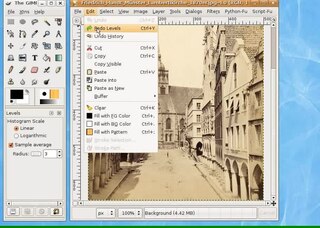
A screencast is a digital recording of computer screen output, also known as a video screen capture or a screen recording, often containing audio narration. The term screencast compares with the related term screenshot; whereas screenshot generates a single picture of a computer screen, a screencast is essentially a movie of the changes over time that a user sees on a computer screen, that can be enhanced with audio narration and captions.

Fraps is a benchmarking, screen capture and screen recording utility for Windows developed by Beepa. It can capture from software that uses DirectX and OpenGL, such as PC games.

AMD Software is a device driver and utility software package for AMD's Radeon graphics cards and APUs. Its graphical user interface is built with Qt and is compatible with 64-bit Windows and Linux distributions.
This page provides a comparison of notable screencasting software, used to record activities on the computer screen. This software is commonly used for desktop recording, gameplay recording and video editing. Screencasting software is typically limited to streaming and recording desktop activity alone, in contrast with a software vision mixer, which has the capacity to mix and switch the output between various input streams.
Snagit is screen capture and screen recording software for Windows and macOS. It is created and developed by TechSmith and was first launched in 1990. Snagit is available in English, French, German, Japanese, Portuguese and Spanish versions.
Video Decode and Presentation API for Unix (VDPAU) is a royalty-free application programming interface (API) as well as its implementation as free and open-source library distributed under the MIT License. VDPAU is also supported by Nvidia.
High Efficiency Video Coding (HEVC), also known as H.265 and MPEG-H Part 2, is a video compression standard designed as part of the MPEG-H project as a successor to the widely used Advanced Video Coding. In comparison to AVC, HEVC offers from 25% to 50% better data compression at the same level of video quality, or substantially improved video quality at the same bit rate. It supports resolutions up to 8192×4320, including 8K UHD, and unlike the primarily 8-bit AVC, HEVC's higher fidelity Main 10 profile has been incorporated into nearly all supporting hardware.
HTML video is a subject of the HTML specification as the standard way of playing video via the web. Introduced in HTML5, it is designed to partially replace the object element and the previous de facto standard of using the proprietary Adobe Flash plugin, though early adoption was hampered by lack of agreement as to which video coding formats and audio coding formats should be supported in web browsers. As of 2020, HTML video is the only widely supported video playback technology in modern browsers, with the Flash plugin being phased out.

x265 is an encoder for creating digital video streams in the High Efficiency Video Coding (HEVC/H.265) video compression format developed by the Joint Collaborative Team on Video Coding (JCT-VC). It is available as a command-line app or a software library, under the terms of GNU General Public License (GPL) version 2 or later; however, customers may request a commercial license.

VP9 is an open and royalty-free video coding format developed by Google.

OBS Studio is a free and open-source, cross-platform screencasting and streaming app. It is available for Windows, macOS, Linux distributions, and BSD. The OBS Project raises funds on Open Collective and Patreon.
NvidiaShadowPlay is a hardware-accelerated screen recording utility available as part of Nvidia's GeForce Experience software for GeForce GPUs. Launched in 2013, it can be configured to record a continuous buffer, allowing the user to save the video retroactively. ShadowPlay is supported for any Nvidia GTX 600 series card or higher.
Video Code Engine is AMD's video encoding application-specific integrated circuit implementing the video codec H.264/MPEG-4 AVC. Since 2012 it was integrated into all of their GPUs and APUs except Oland.

ShareX is a free and open-source screenshot and screencast software for Windows. It is published under the GNU General Public License. The project's source code is hosted on GitHub. It is also available on the Microsoft Store and Steam.
Nvidia NVENC is a feature in Nvidia graphics cards that performs video encoding, offloading this compute-intensive task from the CPU to a dedicated part of the GPU. It was introduced with the Kepler-based GeForce 600 series in March 2012.
The Radeon 400 series is a series of graphics processors developed by AMD. These cards were the first to feature the Polaris GPUs, using the new 14 nm FinFET manufacturing process, developed by Samsung Electronics and licensed to GlobalFoundries. The Polaris family initially included two new chips in the Graphics Core Next (GCN) family. Polaris implements the 4th generation of the Graphics Core Next instruction set, and shares commonalities with the previous GCN microarchitectures.

Guvcview is a webcam application, i.e. software to handle UVC streams, for the Linux desktop, started by Paulo Assis in 2008. The application is written in C and is free and open-source software released under GPL-2.0-or-later.
AOMedia Video 1 (AV1) is an open, royalty-free video coding format initially designed for video transmissions over the Internet. It was developed as a successor to VP9 by the Alliance for Open Media (AOMedia), a consortium founded in 2015 that includes semiconductor firms, video on demand providers, video content producers, software development companies and web browser vendors. The AV1 bitstream specification includes a reference video codec. In 2018, Facebook conducted testing that approximated real-world conditions, and the AV1 reference encoder achieved 34%, 46.2%, and 50.3% higher data compression than libvpx-vp9, x264 High profile, and x264 Main profile respectively.
Nvidia NVDEC is a feature in its graphics cards that performs video decoding, offloading this compute-intensive task from the CPU. NVDEC is a successor of PureVideo and is available in Kepler and later NVIDIA GPUs.
CloudApp is a cross-platform screen capture and screen recording desktop client that supports online storage and sharing.








